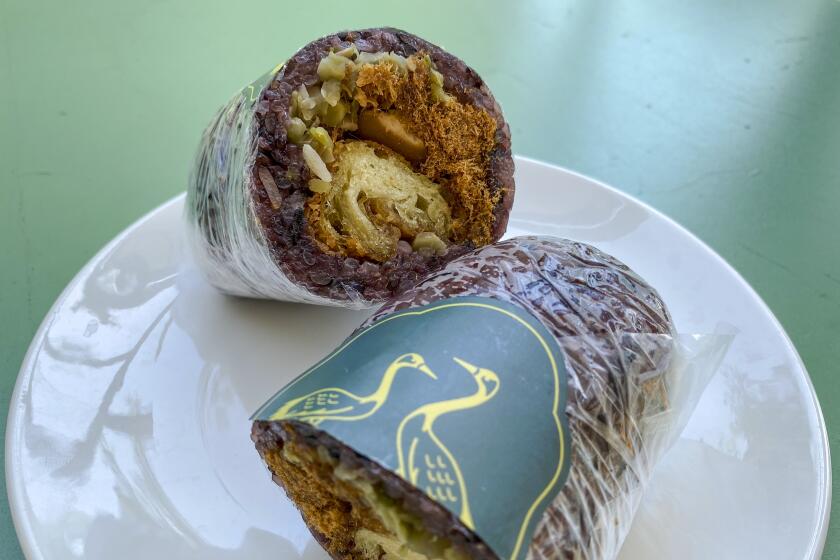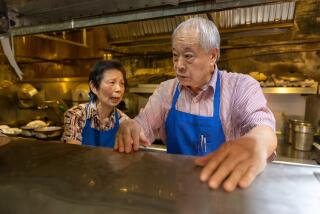Dingding Hu / For The Times
Golden crullers, dipped in soy or served with rice porridge, are more than breakfast — they’re a symbol of resilience
- Share via
Here’s the vibrant scene whenever my parents host a family gathering at their San Gabriel Valley home: They set down bowls and platters of their tried-and-true dishes — from red pungent shrimp to green fish curry noodles — in a steady stream onto the same glossy dining table they’ve had for 30 years. Their grandchildren zip around them like tornadoes. And on the days when my parents announce, “The yu char kway is ready” in our Chinese dialect, Teochew, little hands reach up to the table to grab them. So do mine with the same excitement.
Yu char kway is a beloved breakfast pastry in East and Southeast Asian cuisines, and goes by many names. In Mandarin, it’s referred to as “youtiao”; in Vietnamese, “dầu cháo quẩy.” Also commonly called “Chinese crullers” or “doughnuts,” they’re two golden, deep-fried dough strips — often the length of a forearm — stuck together like butterfly wings. I’ve eaten hundreds of them in my life. The hallmark of a quality cruller is a crunchy outside, with a chewy and airy filling. Unlike the American doughnut, these aren’t sweet but lightly salted.
For my family, they’re not just doughnuts but rather a symbol of resilience in the face of war and genocide. My parents, who grew up in Phnom Penh, Cambodia, have always found ways to weave stories about their lives into the foods they cook.
Find the best Chinese doughnuts at these 10 places in the Los Angeles area, with many of the greatest spots located in the San Gabriel Valley.
When I was a child, there were times I’d be fascinated by these stories. But my mother would repeat them so often, I’d inevitably get annoyed hearing them for the umpteenth time and zone out. Now, I realize the humble Chinese doughnut was a storytelling vehicle for so much of my family’s history and their transnational migration to America.
“In Cambodia, we’d only see Chinese doughnuts in coffee shops,” my mother recalled. “People would dunk them in coffee, or dip them in soy sauce to accompany rice porridge. We didn’t really eat them as kids because we didn’t have a lot of money to spend.”
But when the brutal Khmer Rouge regime took over Cambodia, my family embarked on a journey where the Chinese doughnut would essentially save their lives. The soldiers stormed my parents’ bustling city on April 17, 1975, forcing them and everyone else out of their homes and to the countryside. At the time, my mother and father, who were 25 and 35, respectively, had two young children. They were able to bring only enough clothes, supplies and food for three days.
“A Khmer Rouge soldier tore a 5,000 Cambodian riel bill in front of us to show us our money no longer mattered,” my mother said. Over the next five years, the country didn’t have a monetary system.
For two months, my family wandered between Cambodia and Vietnam, sleeping on the streets and taking refuge where they could. They wondered if they could ever return home as they saw dead bodies on the roadsides and families torn apart.
My parents made the decision to trek to a refugee camp at the Cambodia-Vietnam border. They were considered the lucky ones who got out and weren’t forced into labor camps, like my maternal grandmother, who died in one. It’s estimated that by 1979, more than 2 million Cambodians died by execution, disease and starvation.
After a year of languishing in the refugee camp and finding it difficult to get enough to eat, a friend of my parents recommended my father for work at a cafe in Saigon. While my father’s main job was to boil water for coffee, he gained other important skills there.
“I watched the chef prepare Chinese doughnuts every day,” my father said.
With the help of my mother’s aunt who gave my parents some cash to get started with their new lives in Saigon, my father was able to buy a bicycle and become a middleman between doughnut purveyors and restaurants.
Eventually, my parents were able to buy woks, stoves and flour to make their own doughnuts. It took them a while to get it right.
“We couldn’t bear to waste the dough that didn’t rise, so we’d cut them into noodles,” my mother said. “We ate so many noodles in those days.”
When I watch my parents make Chinese doughnuts today, it’s like a dance. Each at their respective stations, they move in synchronicity. My father, while donning an In-N-Out paper hat and white apron, will knead the dough, roll it out flat and slice it into rectangles with a butcher’s knife.
My mother stands by the wok with a pair of foot-long wooden chopsticks, nimbly dropping the dough into the bubbling oil, flipping and lifting it out when it’s a sun-kissed pillowy cruller.
“I still have a callus on my finger from using chopsticks to flip doughnuts all those years,” my mother said.
My family had lived in Saigon for four years, and during that time, their Chinese doughnut business boomed. They would produce at least 500 a day.
“The salary people made in a month, we made in a day,” my mother said. “We had enough to pay the rent and for our livelihood.”
Chinese doughnuts helped them start over.
Working out of their 500-square-foot studio, with the walls covered in soot from all the deep frying, they perfected their recipe. Almost every family member had a job. They’d get started at midnight and work through the night so my father could deliver the doughnuts to cafes in the morning. My brothers would grab a basket of doughnuts and sell them to passersby on the street, wrapping each one in newspaper. Customers would dunk the doughnuts in pork blood porridge and Vietnamese coffee.
“Your father was so good at doing business,” my mother said. “At the end of the day, he would walk around and exchange our remaining doughnuts with vendors for fruit, zongzi (bamboo-leaf-wrapped glutinous rice dumplings) and pastries.”
That moment of prosperity came to an end in 1979, when my family, which had grown with the addition of my sister, had to leave Vietnam. They heard news about the Vietnamese government cracking down on Cambodian nationals living in Saigon. My family left everything behind again to go on a treacherous journey to a refugee camp at the Thailand-Cambodia border in hopes of finding a way out. Through the Red Cross, a church in Wisconsin sponsored my family. In 1981, they flew on a plane to America. My mother was three months pregnant with me.
My family’s story runs parallel to the Chinese doughnut’s origin, in that they both had roots in political upheaval. As the story goes, the cruller was created during China’s Southern Song Dynasty in the 12th century as a response to what was believed to be the unjust execution of war hero Yue Fei, instigated by the lies of chancellor Qin Hui. Fei’s supporters attached two pieces of dough to represent Hui and his wife, and fried it in boiling oil as a way to deal with their anger and sadness.
Stories like these are fading, as well as my own memories. I patiently listen to my parents, who are now in their 70s and 80s, tell their stories again and again. I ask them to make their Chinese doughnuts, and I scramble to record videos and write down their recipes and stories. I’m afraid to lose this piece of our history. It’s like the sands of time are slipping through my hands.
Recently when I bought a cruller at a Chinatown bakery for my 3-year-old daughter, I found myself telling her stories about my parents and what this savory pastry means to us.
“It’s so yummy,” she said.
It’s OK that she isn’t able to absorb all this information now. It’s not going to be the last time I tell her.
More to Read
Eat your way across L.A.
Get our weekly Tasting Notes newsletter for reviews, news and more.
You may occasionally receive promotional content from the Los Angeles Times.











